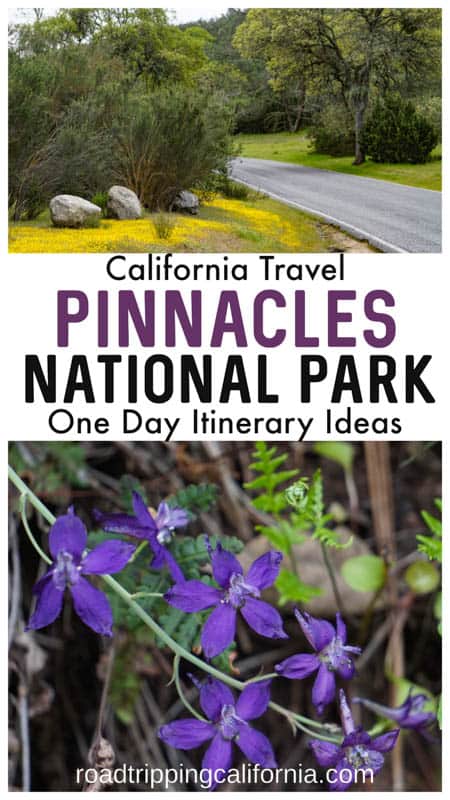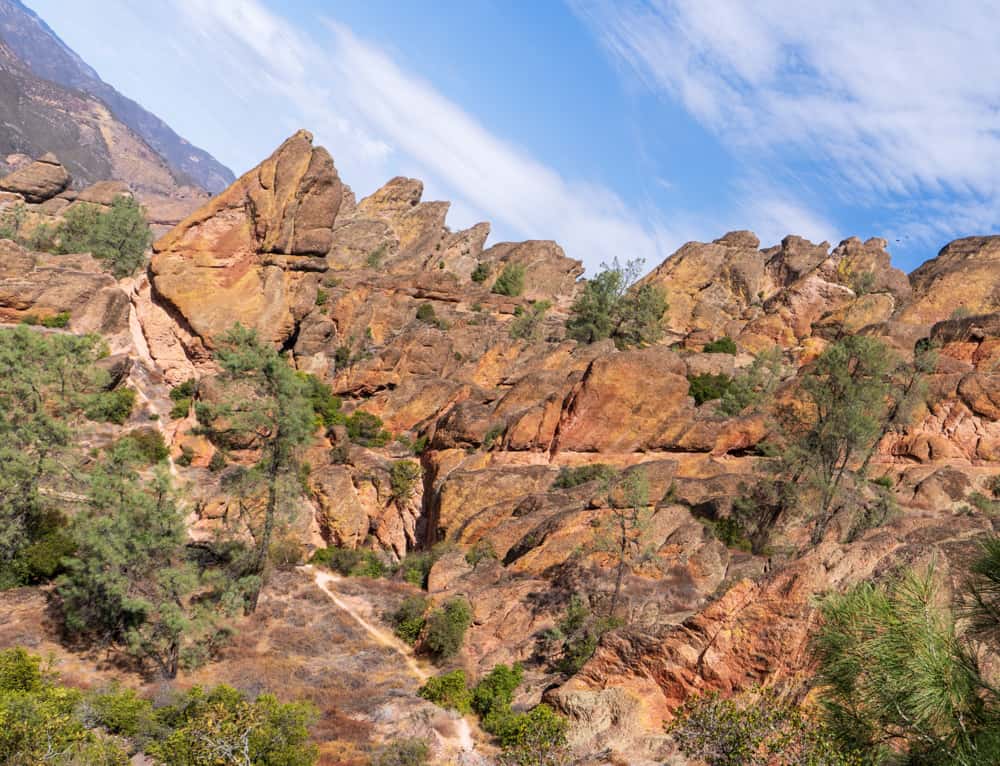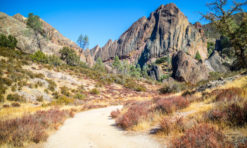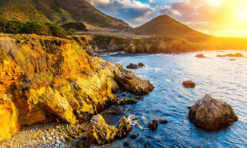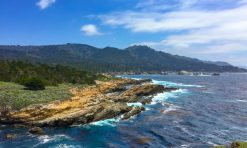One day in Pinnacles National Park allows you time to do some epic hiking, explore talus caves, admire and photograph wildflowers (if you visit in season), and look for California condors and other birds and wildlife.
Pinnacles National Park is the youngest and the smallest of California’s national parks, and a must-visit for its namesake pinnacles and must-do hiking trails.
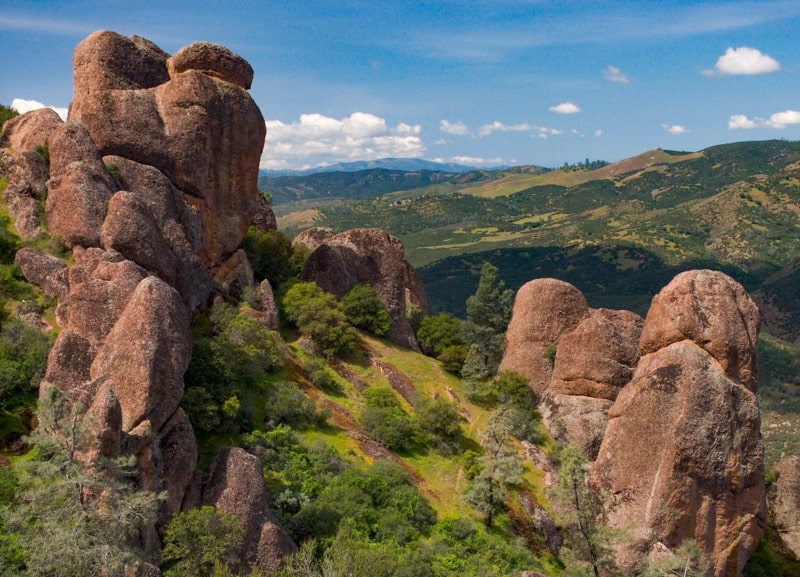
Some links on this page may be affiliate links. If you click an affiliate link and make a purchase, we may receive a small commission, at no extra cost to you. For more details, refer to our disclosure.
While hiking is the major reason why you’d visit Pinnacles National Park, you can also go rock climbing here, and, if you stay late into the day, you can also look into evening ranger-led programs or do some stargazing on your own.
Pinnacles National Park Overview
Located in central California, east of the Salinas Valley, Pinnacles National Park makes for an easy day trip from San Francisco, the Monterey Peninsula, or the California Central Coast.
Visitors enjoy Pinnacles National Park for its unique natural features and the abundant wildlife and birds in the area.
The park is not as crowded as some of the other national parks in the state, so you will have the chance to experience the wilderness in relative quiet and solitude here, especially if you time your visit right.
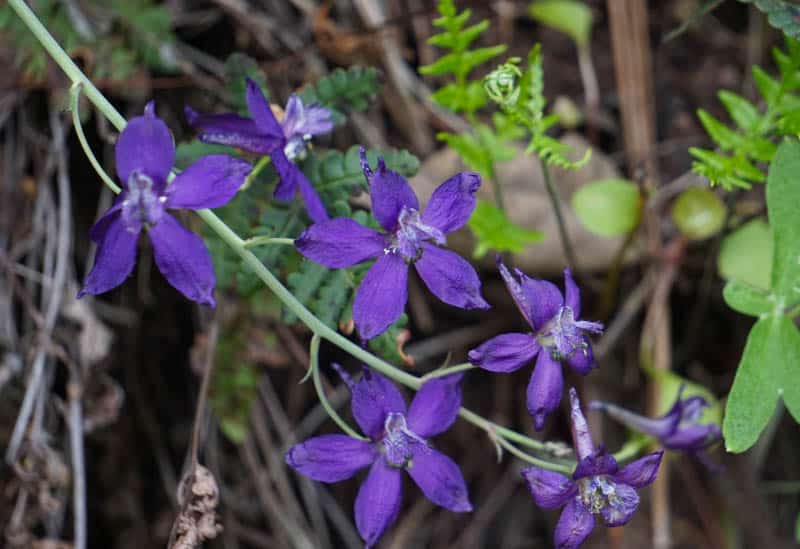
Aside from the signature spires that give the park its name, the two Pinnacles National Park caves, Bear Gulch Cave and Balconies Cave, are big draws. The caves are talus caves, formed by the caving in of walls of rock.
Pinnacles National Park trails come in varying lengths and difficulty levels. With over 30 miles of hiking trails available, you can be reasonably sure of finding one or two hiking trails at Pinnacles that will work for you!
Pinnacles National Park Entrances
There are two entrances to Pinnacles National Park. The east entrance is near the town of Hollister, and the west entrance near the town of Soledad.
It is important to note that there is no road through the park, and driving around, from one entrance to the other, will take well upwards of an hour.
The east entrance is probably the better option if you are visiting Pinnacles National Park for the first time, or if you are visiting with young kids, or looking for a wider choice in terms of hiking trails.
It is also the nearer entrance if you are visiting from the San Francisco Bay Area or other places north of the park.
The visitor center at the east entrance is larger, and there’s a store here that carries some hiking and camping supplies. The Pinnacles campground is by the east entrance.
The west entrance has a few nice trails as well, and it can be less crowded in season. If you live in the Monterey Bay area, or are visiting from other places south of the park, the west entrance will be closer.
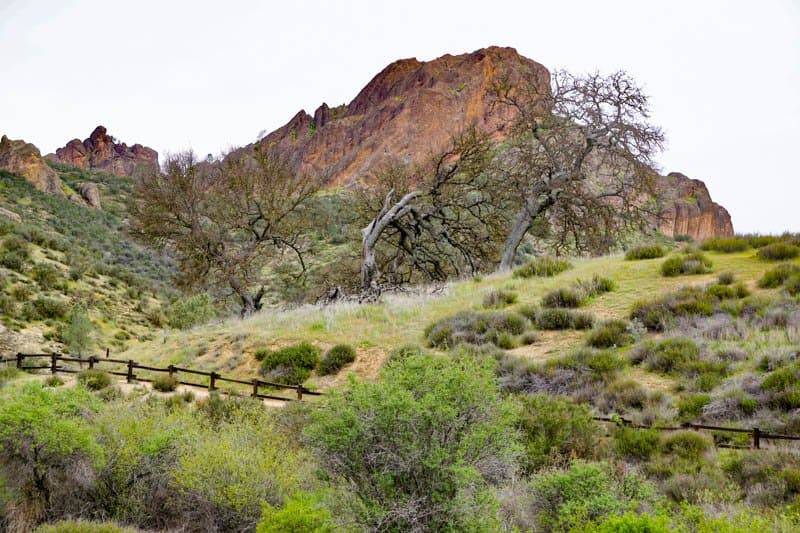
Structuring Your Pinnacles National Park Itinerary
My itineraries below are geared primarily towards hikers that like mostly easy to moderate hikes with a couple of short challenges along the way.
I have suggested ways to modify the hikes if you do not wish to encounter the more challenging portions.
If you are visiting for half a day, you can pick from the morning or afternoon options for a few enjoyable hours of hiking in the park.
And if you are up for a more challenging full day, you can do a strenuous loop through the park that will take you through many exciting parts of Pinnacles National Park in one long stretch.
I have suggested one full-day, challenging route from each entrance below.
Pinnacles National Park One Day Itinerary: West Entrance
If you arrive at the west entrance to Pinnacles National Park, continue driving past the visitor contact station to the Chaparral parking area, from where trails lead into the heart of the park and to the Balconies Cave.
Morning: Juniper Canyon Trail to High Peaks Trail (Loop, 4.3 miles)
We hiked the Juniper Canyon Trail up to the High Peaks Trail. If you complete the full loop, it is a challenging hike, and will take about 3 hours with stops to take photos and to observe flora and fauna.
But the first part of the trail is not difficult, and it’s quite scenic. If you do not wish to do the full loop, go as far as you are able and then return the same way. The trail is beautiful in the spring, with some shade in the first part as you walk through the canyon.
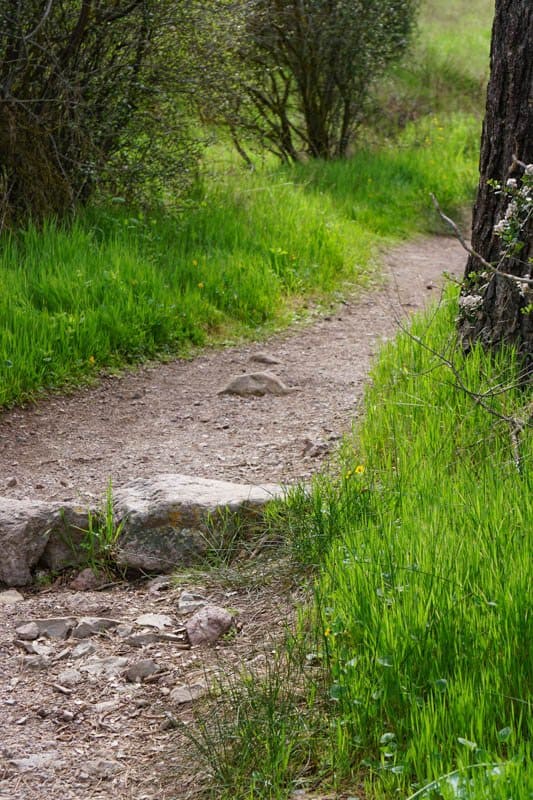
Once you leave the canyon, the trail climbs through a series of switchbacks to an overlook near Scout’s Peak, from where you get panoramic views of the park. Here’s where you have a good chance of seeing a condor or two.
After you’ve rested for a bit, get ready to tackle the “steep and narrow” portion of the High Peaks Trail. There are handrails and “steps” carved into the rock face to help you navigate the spires, but it’s still anxiety-inducing if you’re like me.
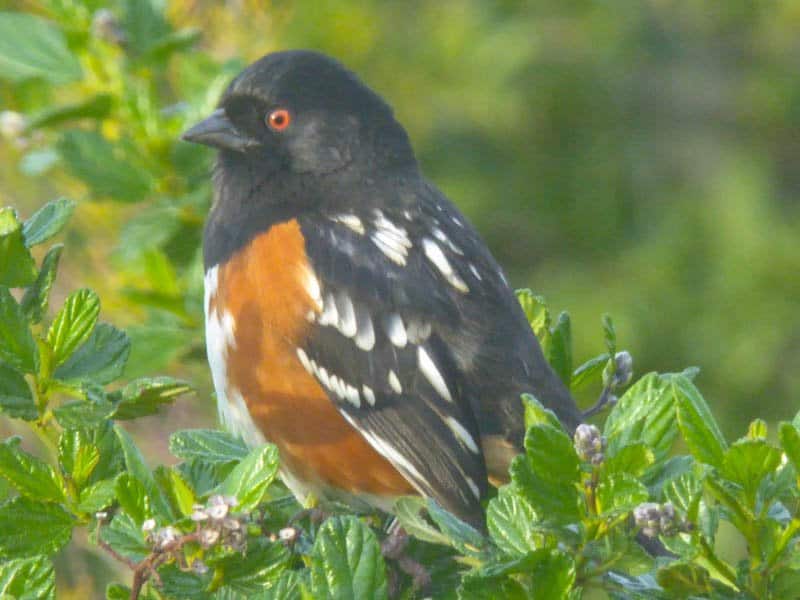
Once you’ve navigated the steep and narrow part of the trail, about 0.7 mile, take the Tunnel Trail, which is where you will start making your way back down.
The Tunnel Trail is not as steep, and eventually meets up with the Juniper Canyon Trail. Take a right at the junction to head down to the parking area.
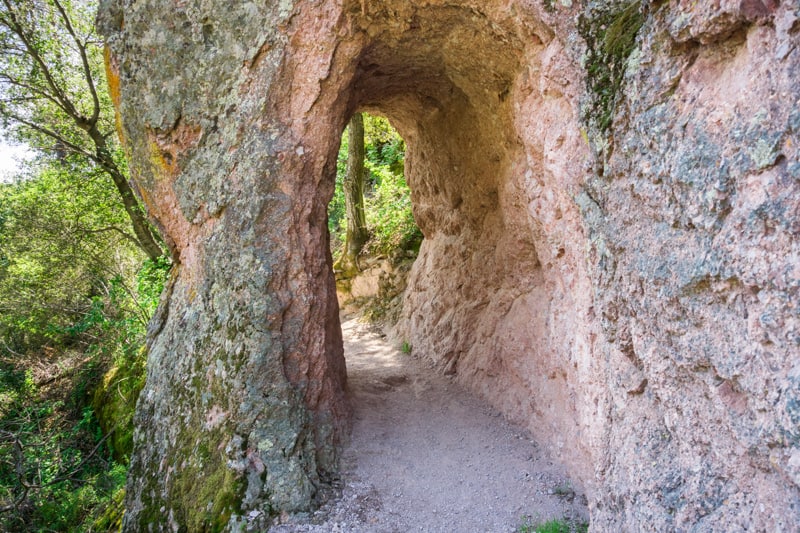
There are picnic tables at the Chaparral parking area, where you can have your lunch. There are restrooms as well. No food is sold at the west entrance to the park, so bringing a picnic lunch, or snacks, is a good idea!
Afternoon: Balconies Cliffs and Cave Trails (LOOP, 2.4 miles)
You can’t visit Pinnacles National Park and not step inside one of its two talus caves, if they happen to be open when you visit. From the west entrance, the Balconies Cave is an easy hike.
You can either just hike to the cave and back, or combine your visit to the cave with the cliffs trail, which affords excellent views of the Balconies and the Machete Ridge, two of the iconic pinnacle formations in the park.
If you start with the Balconies Cliffs trail, it goes up and over the cave, then comes down on to the Old Pinnacles Trail, which you can follow into the Balconies Cave. Explore the cave, and them head back to the Chaparral parking area.
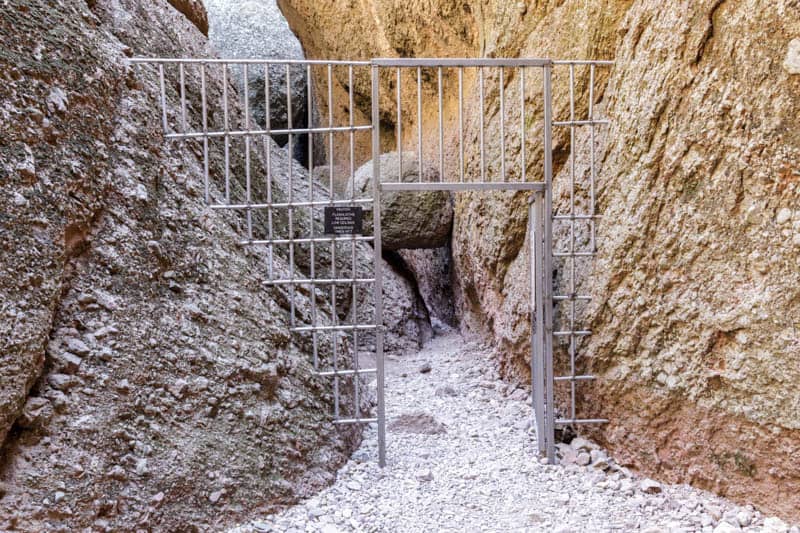
From the parking lot to the cave, the trail is flat and easy. Going over the cave does involve some elevation, but it is a short stretch and not difficult.
Inside the cave, you will have to do some scrambling and squeezing your way past rocks. It’s pitch dark, and good to have your hands free, so a headlamp is very handy. And in the winter and spring, the cave floor is apt to be wet, so water shoes are helpful.
Old Pinnacles Trail (Optional)
If you have the time, and you are up for more relatively flat hiking, you can explore more of the Old Pinnacles Trail before you retrace your steps to the Balconies Cave.
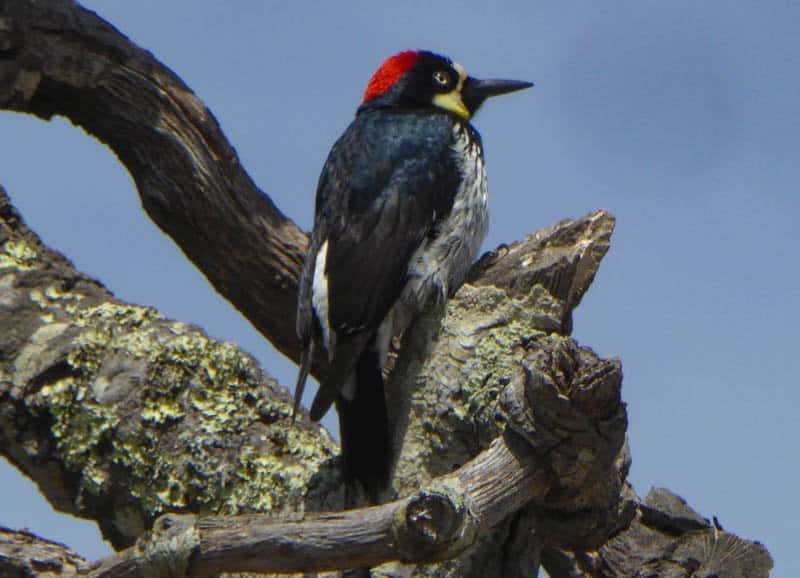
The Old Pinnacles Trail goes on for about 1.3 miles from the Balconies Cave, to the Old Pinnacles parking area. There isn’t any shade on this trail though, so you might want to do it only if temperatures are comfortable.
The trail winds its way along the west fork of the Chalone Creek, and in season, you’ll see lots of wildflowers. And keep your eyes peeled for birds and bees.
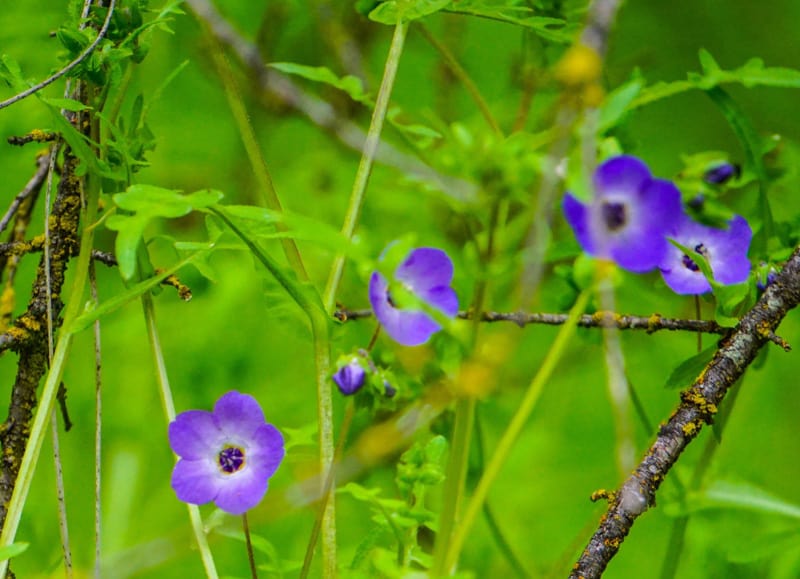
Full Day Alternate Challenging Itinerary from West Entrance (Loop, ~ 9 Miles)
From the Chaparral parking area, walk up the Juniper Canyon Trail to High Peaks Trail as described above. Instead of taking the Tunnels Trail, continue on the High Peaks Trail to the Condor Gulch Trail viewpoint. This viewpoint is one of the most scenic in the park.
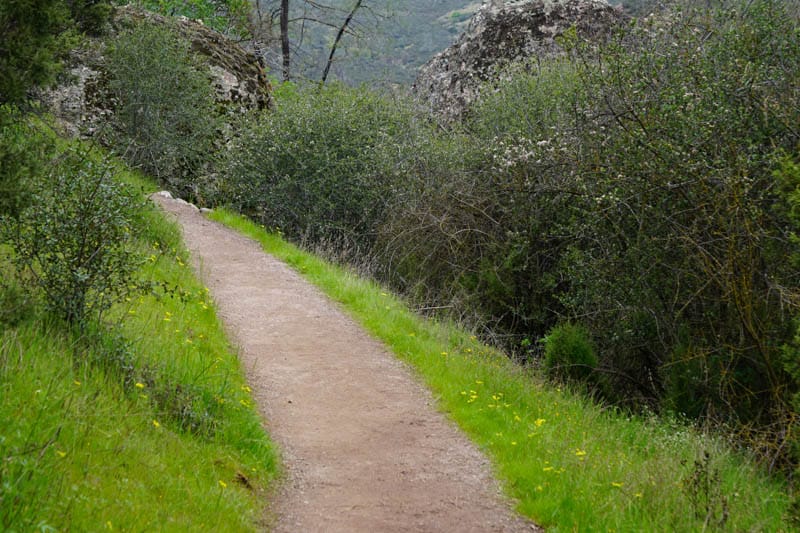
Hike Condor Gulch Trail to Sycamore Trail. Turn left onto Sycamore Trail. At the Manzanita parking area, make a left and continue on to the Old Pinnacles parking area.
Continue on the Old Pinnacles Trail to the Balconies Cliff Trail, which will lead you up and over the Balconies Cave and back to the Chaparral parking area.
This loop is a little more than 9 miles, and will take you anywhere from 6 to 8 hours with breaks for photos, to observe flora and fauna, and for a meal. It does not include exploring the Balconies Cave, but if it is open and you have the time, you can go through the cave instead of up and over it.
Pinnacles National Park One Day Itinerary: East Entrance
If you arrive at the east entrance to Pinnacles National Park, you have several parking areas from which to pick.
For the itineraries I have described you’d want to try to park in the Moses Spring parking area, or failing that, at the Peaks View parking area.
This morning itinerary assumes that you were able to find parking at the Moses Spring parking area.
If you had to park further out, such as at Peaks View, Manzanita, or Old Pinnacles, you’ll have to walk a fair bit to arrive at the trailhead at Moses Spring, and will likely not have the time to walk too much of the High Peaks Trail.
Morning: Moses Spring Trail to Rim Trail (and A Bit Of High Peaks)
The Moses Spring and Rim trails start at the trailhead at the Moses Spring parking area, and join to other trails that take you into the higher elevations of the park.
The Moses Spring Trail and Rim Trail loop by itself is a great option if you are visiting with young children. It also includes a bit of everything that’s fun about Pinnacles: a cave, rock formations, wildflowers and the opportunity to spot birds.
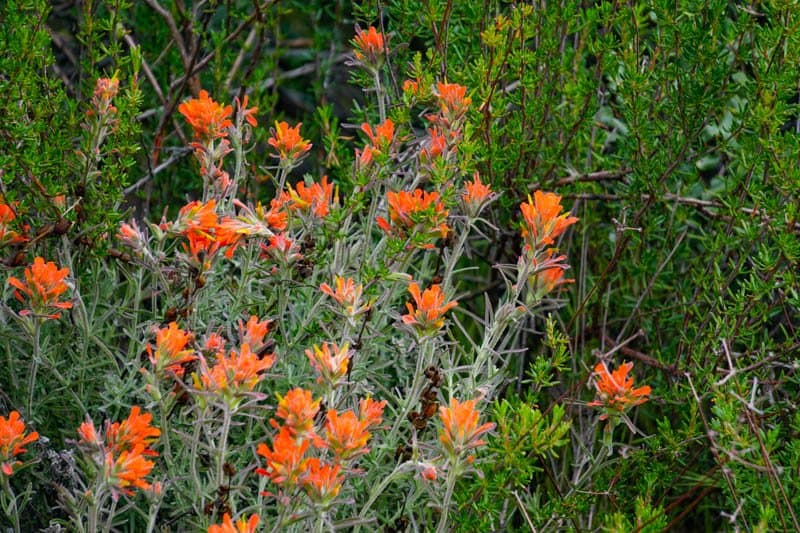
The loop is about 2.2 miles in total, with not much of an elevation jump. It is the most popular trail at Pinnacles National Park, because it is short and super scenic.
If Bear Gulch Cave is a must-see for you, check the status before you arrive to make sure it is open.
The Moses Spring Trail has some shade, and goes gently uphill to meet the Bear Gulch Cave trail, which will lead you to the cave entrance. You will have to be prepared for some scrambling and stairs to navigate the cave.
You can also stay on the Moses Spring Trail to skirt the cave and go to the reservoir.
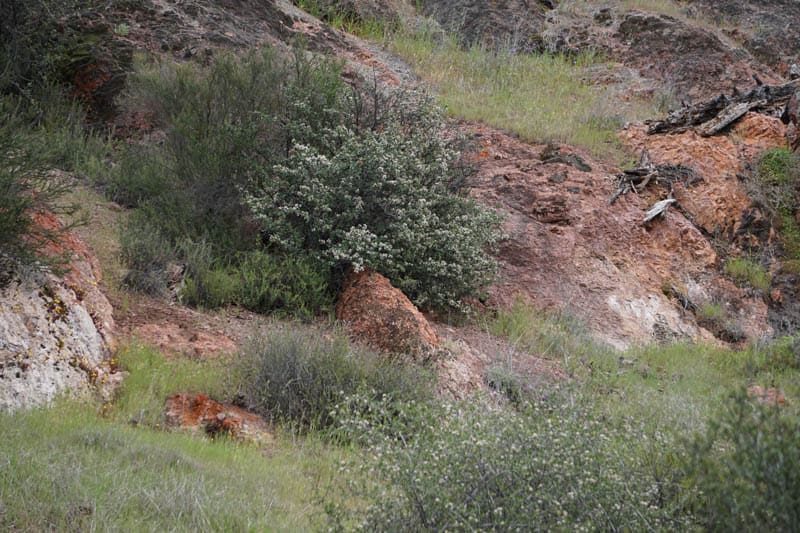
A headlamp is advised, so your hands stay free and you can explore the cave comfortably, and water shoes, since there might be water on the floor of the cave.
After you explore the cave, climb up the stairs near the cave exit to look out at the beautiful Bear Gulch Reservoir. This is a great spot for a little break as you soak in the views.
Next, it’s on to the Rim Trail, which is exposed and at a higher elevation. The views are beautiful, but watch your step: there is no railing. The Rim Trail meets up with the High Peaks Trail.
If you have the time and the energy, you can walk these higher elevations of the park for a bit before you turn back and make your way back to the Moses Spring trailhead, and then to the Bear Gulch Day Use Area.
The High Peaks Trail stretch from the Rim Trail junction to the steep and narrow section is about 1.5 miles one way, and you can go as far as you find comfortable.
If you brought a picnic lunch, there are picnic tables at the Bear Gulch Day Use Area. There are restrooms here as well.
Afternoon: Condor Gulch Trail to High Peaks Trail
Next, it’s time to make the trek to one of the most scenic overlooks in the park. From the trailhead at the Bear Gulch Day Use Area, hike the Condor Gulch Trail. This trail is 1.7 miles each way, and the scenic overlook comes up at the one mile mark.
Condor Gulch Trail is considered moderately difficult until the overlook, and strenuous beyond. At its endpoint, Condor Gulch Trail meets up with the High Peaks Trail.
If you did not get the chance to hike some of the High Peaks Trail in the morning, you can opt to walk a stretch of it at this time, before you make your way back.
You should be able to walk about 0.6 mile until the junction with Tunnel Trail, at which time you can start retracing your steps to Condor Gulch Trail and back down to the trailhead.
Full Day Alternate Challenging Itinerary from East Entrance (Loop, 6.1 Miles)
This full day itinerary takes between 5.5 and 7 hours, with stops for photos, to observe flora and fauna, to admire the views, and for a meal.
It also assumes that you were able to find parking at the Bear Gulch Day Use Area. If you parked further away at Peaks View, you will have to walk another 1.2 miles or so each way.
On this epic loop, you will hike up Condor Gulch Trail, past the scenic overlook, to the High Peaks Trail, and walk the full length of the High Peaks Trail, including the steep and narrow section.
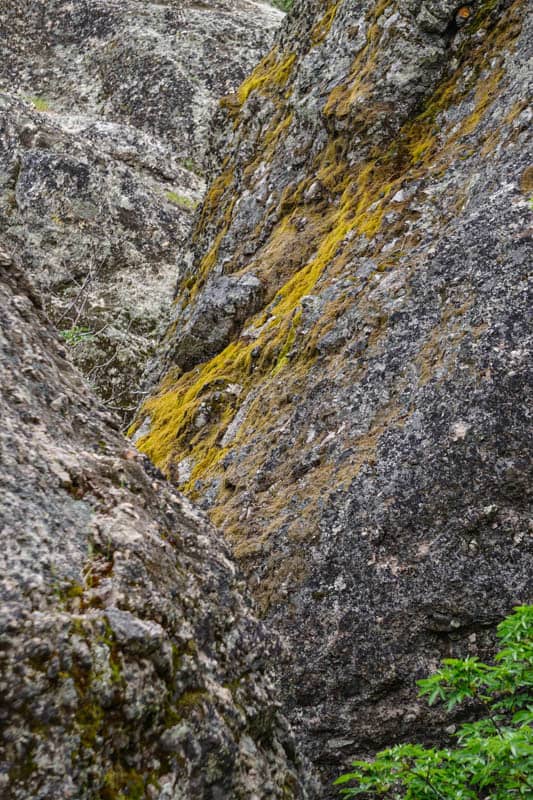
Once you come back down to the Moses Spring trailhead, take the Moses Spring Trail to Bear Gulch Cave and Bear Gulch Reservoir. Then hike the Rim Trail back to the Moses Spring parking area.
On this itinerary, you get to experience the best aspects of Pinnacles National Park, including exploring a talus cave, hiking among the tall pinnacles, looking for condors and other wildlife, enjoying fabulous views and wildflowers in season, and views of the Bear Gulch Reservoir.
Looking to spend more than one day in the park? Check out our comprehensive guide to Pinnacles National Park for suggestions on places to stay, and other relevant information about the park.
Getting to Pinnacles National Park
From the North
East Entrance to Pinnacles National Park
If you are visiting from the San Francisco Bay Area (north of the park), take Highway 101 South to Highway 25 South. Go through Hollister to Highway 146. Turn right on Highway 146, and then left at the Pinnacles National Park Campground and Visitor Center.
West Entrance to Pinnacles National Park
If you are visiting from the San Francisco Bay Area (north of the park), take Highway 101 South to Highway 146 at the town of Soledad. Highway 146 will take you into the park to the visitor center.
Highway 146 is very narrow for part of the way, not suitable for wide RVs and the like.
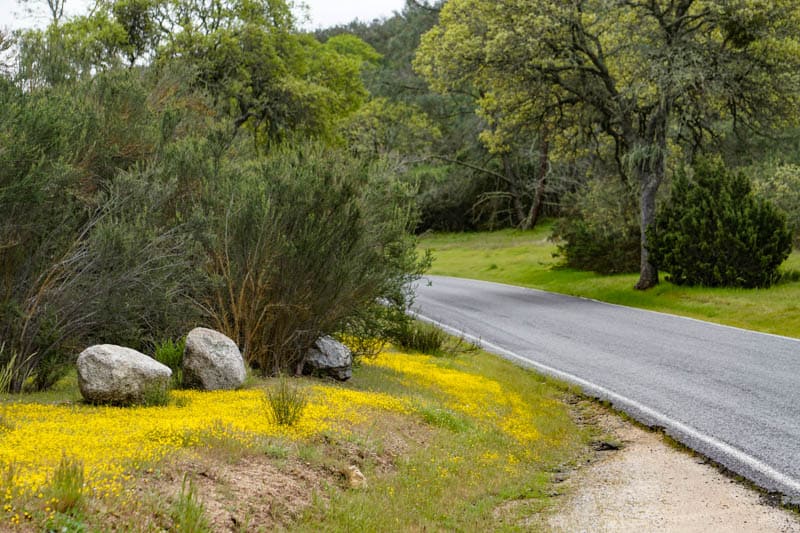
From the South
East Entrance to Pinnacles National Park
Take Highway 101 North to King City. Take the First Street exit (it becomes Bitterwater Road) to Highway 25. Make a left onto Highway 25 and then left onto Highway 146 to enter the park.
West Entrance to Pinnacles National Park
Take Highway 101 North to Highway 146 at the town of Soledad. Take Highway 146 East into the park. Be aware that Highway 146 is a narrow one-lane road for part of the way, not suitable for big RVs.
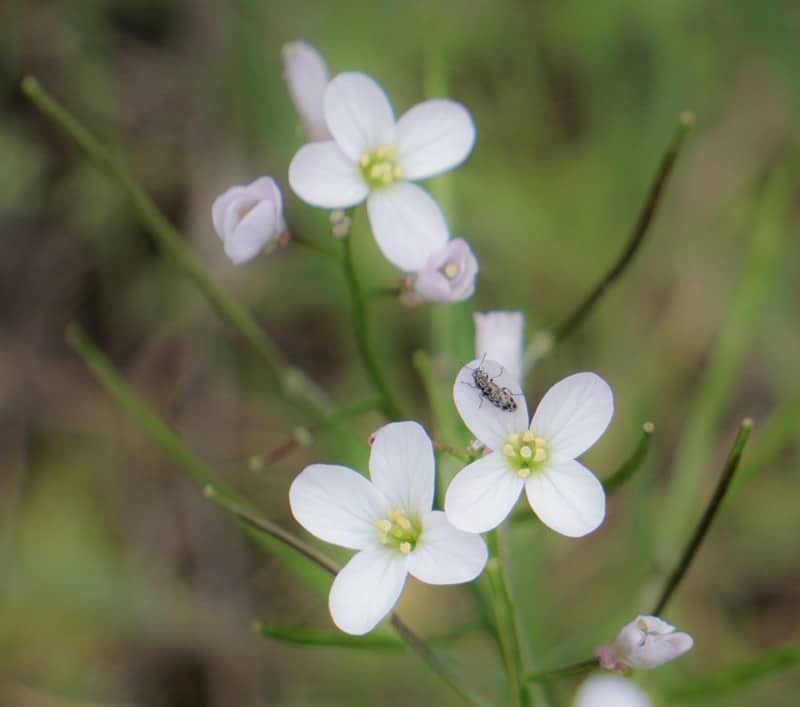
Parking at Pinnacles National Park
There are a couple of parking areas near the west entrance, and several parking areas near the east entrance to Pinnacles National Park. The Chaparral parking area in the west, and the Moses Spring or Peaks View parking areas in the east are closest to the hiking trails in the heart of the park.
However, none of the parking areas is particularly large, so if you want to be sure of a spot when you arrive, come early in the day, especially if you visit in high season (March – May).
Also, the parking areas are spread out quite a bit, so if you have limited time to spend in the park, you will want to arrive early to get a spot at a parking area that’s close to the trails you want to hike. There’s a shuttle that runs in season on the east side, so call to see if it’s operating when you plan to visit.
You can see all the parking areas and all the trails on this Pinnacles National Park map.
Pinnacle National Park Hours
The east entrance to the park is generally open everyday between 8 a.m. and 6 p.m. The west entrance is open everyday between sunrise and sunset. For notices about special closures and other current status reports, visit the park website.
When to Visit Pinnacles National Park
The best time to visit Pinnacles National Park is undoubtedly spring, when wildflowers are in bloom, the park is lush and green, and daytime temperatures are pleasant. We have visited twice between mid March and mid April, and each visit has been bountiful in terms of wildflower blooms.
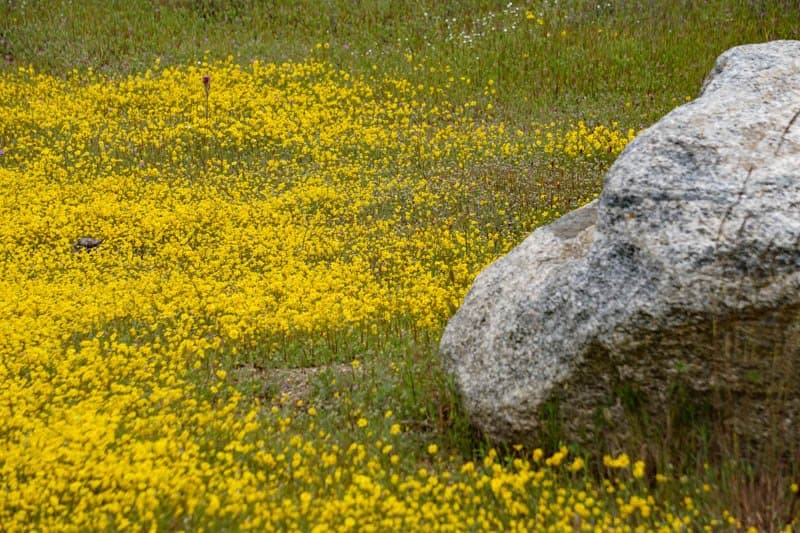
But spring is also the time when the hiking trails at Pinnacles are likely to be at their busiest. Late fall and winter are quieter, with daytime temperatures in the park pleasant for hiking.
Bear in mind that winter and spring are rainy season in California, so pick a dry spell to visit.
Avoid summer if you can: the park often has extreme heat advisories posted in summer, when temperatures can soar above 100 degrees Fahrenheit.
Hiking in extreme heat is not fun, and you can’t see much at Pinnacles without hiking at least a little bit.
*****
Have you been to Pinnacles National Park? I would love to hear about your visit, if you have! Comment below to respond.
If you have not yet visited, and you enjoy hiking and being out in nature, I hope I have inspired you to plan a trip to Pinnacles National Park!
And if you plan to visit other California national parks, check out our other articles:
- Things to Do in Joshua Tree National Park
- Things to Do in Death Valley National Park
- Things to Do in Redwood National and State Parks
- Things to Do in Lassen Volcanic National Park
- California Desert Road Trip
- Best Hikes in Joshua Tree National Park
Did you find this article informative? Pin it for later reference!
